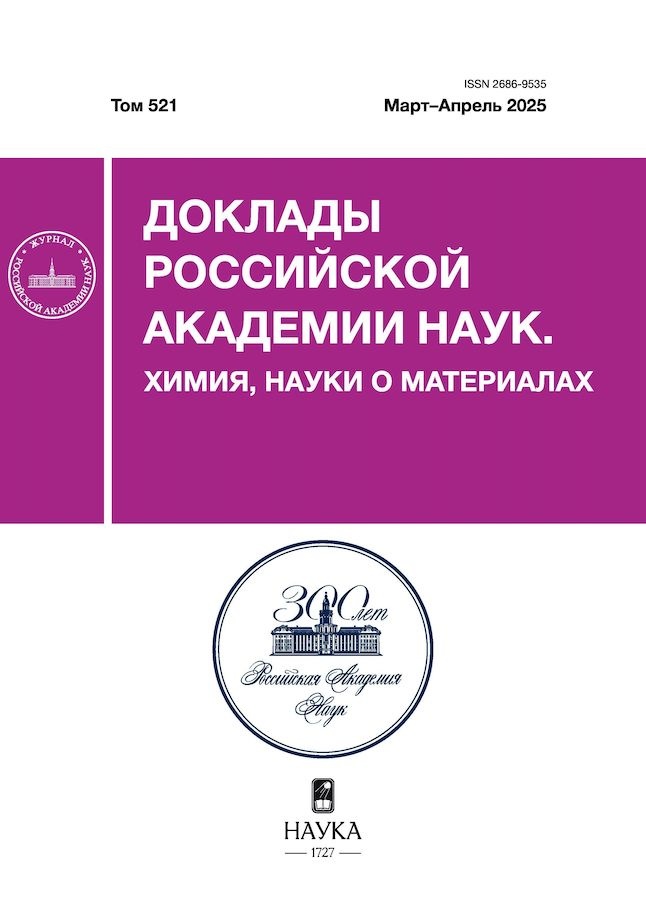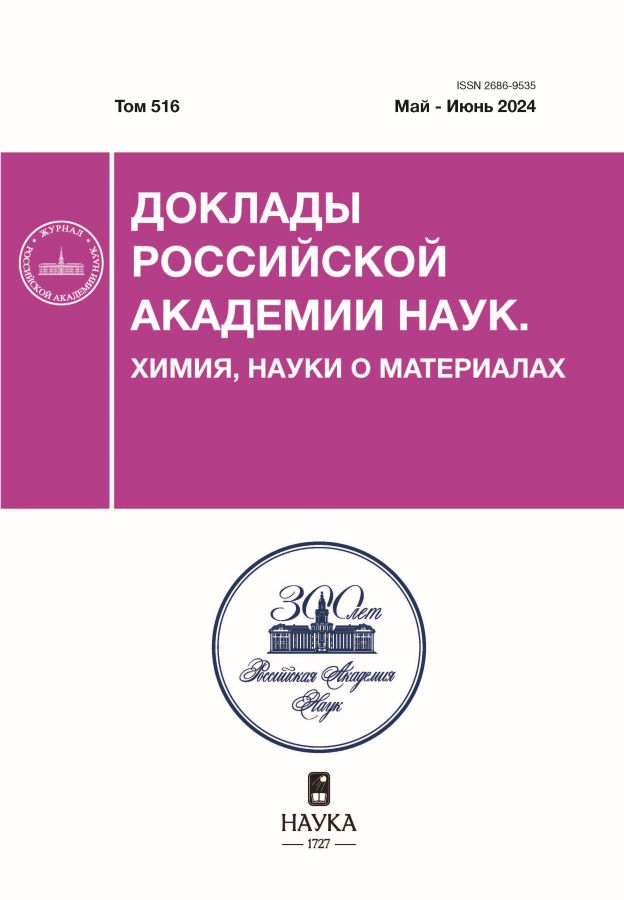Особенности электронного строения (η⁵-C₅H₅)LuCl₂(THF)₃
- Авторы: Лысенко К.А.1, Ройтерштейн Д.М.2,3,4, Бардонов Д.А.2,3,4, Миняев М.Е.2,4
-
Учреждения:
- Московский государственный университет имени М.В.Ломоносова
- Институт органической химии им. Н.Д. Зелинского РАН
- Институт нефтехимического синтеза им. А.В. Топчиева РАН
- Национальный исследовательский университет “Высшая школа экономики”
- Выпуск: Том 516, № 1 (2024)
- Страницы: 52-58
- Раздел: ФИЗИЧЕСКАЯ ХИМИЯ
- URL: https://ter-arkhiv.ru/2686-9535/article/view/651909
- DOI: https://doi.org/10.31857/S2686953524030079
- EDN: https://elibrary.ru/ZIDNKL
- ID: 651909
Цитировать
Полный текст
Аннотация
Впервые проведен топологический анализ функции распределения электронной плотности в кристалле для лантанидорганического соединения на примере комплекса CpLuCl₂(THF)₃. Определены заряды на атомах. Подтвержден преимущественно ионный характер связи Lu–лиганд, но при этом обнаружен существенно-ковалентный характер связи Lu–Cp. Установлены энергии связей Lu–лиганд.
Ключевые слова
Полный текст
Об авторах
К. А. Лысенко
Московский государственный университет имени М.В.Ломоносова
Email: mminyaev@ioc.ac.ru
Россия, 119991 Москва
Д. М. Ройтерштейн
Институт органической химии им. Н.Д. Зелинского РАН; Институт нефтехимического синтеза им. А.В. Топчиева РАН; Национальный исследовательский университет “Высшая школа экономики”
Email: mminyaev@ioc.ac.ru
Россия, 119991 Москва; 119991 Москва; 101000 Москва
Д. А. Бардонов
Институт органической химии им. Н.Д. Зелинского РАН; Институт нефтехимического синтеза им. А.В. Топчиева РАН; Национальный исследовательский университет “Высшая школа экономики”
Email: mminyaev@ioc.ac.ru
Россия, 119991 Москва; 119991 Москва; 101000 Москва
М. Е. Миняев
Институт органической химии им. Н.Д. Зелинского РАН; Национальный исследовательский университет “Высшая школа экономики”
Автор, ответственный за переписку.
Email: mminyaev@ioc.ac.ru
Россия, 119991 Москва; 101000 Москва
Список литературы
- Raymond K.N., Eigenbrot C.W. // Acс. Chem. Res. 1980. V. 13. № 8. P. 276–283. https://doi.org/10.1021/ar50152a005
- Evans W.J. // Polyhedron 1987. V. 6. № 5. P. 803–835. https://doi.org/10.1016/S0277-5387(00)80921-3
- Choppin G.R. // J. Alloys Compd. 2002. V. 344. № 1–2. P. 55–59. https://doi.org/10.1016/s0925-8388(02)00305-5
- Roitershtein D.M., Rybakova L.F., Petrov E.S., Ellern A.M., Anipin M.Yu., Sruchkov Yu.T. // J. Organomet. Chem. 1993. V. 460. № 1. P. 39–45. https://doi.org/10.1016/0022-328X(93)80356-G
- Roitershtein D.M., Minyaev M.E., Lyssenko K.A., Belyakov P.A., Antipin M.Yu. // Russ. Chem. Bull., Int. Ed. 2004. V. 53. № 10. P. 2152–2161. https://doi.org/10.1007/s11172-005-0089-7
- Ellis J.E., Minyaev M.E., Nifant’ev I.E., Churakov A.V. // Acta Cryst., Sect. C. 2018. V. C74. № 6. P. 769–781. http://dx.doi.org/10.1107/S2053229618007295
- Roitershtein D.M., Vinogradov A.A., Vinogradov A.A., Lyssenko K.A., Nelyubina Yu.V., Anan’ev I.V., Nifant’ev I.E., Yakovlev V.A., Kostitsyna N.N. // Organometallics. 2013. V. 32. № 5. P. 1272–1286. https://doi.org/10.1021/om301020r
- Puntus L.N., Lyssenko K.A., Antipin M.Yu., Bünzli J.-C.G. // Inorg. Chem. 2008. V. 47. № 23. P. 11095–11107. https://doi.org/10.1021/ic801402u
- Roitershtein D.M., Puntus L.N., Vinogradov A.A., Lyssenko K.A., Minyaev M.E., Dobrokhodov M.D., Taidakov I.V., Varaksina E.A., Churakov A.V., Nifant’ev I.E. // Inorg. Chem. 2018. V. 57. № 16. P. 10199–10213. http://dx.doi.org/10.1021/acs.inorgchem.8b01405
- Zhurov V.V., Zhurova E.A., Stash A.I., Pinkerton A.A. // J. Phys. Chem. A. 2011. V. 115. № 45. P. 13016–13023. https://doi.org/10.1021/jp204965b
- Koritsanszky T.S., Coppens P. // Chem. Rev. 2001. V. 101. № 6. P. 1583–1628. https://doi.org/10.1021/cr990112c
- Blatov V.A. // Crystallogr. Rev. 2004. V. 10. № 4. P. 249–318. https://doi.org/10.1080/08893110412331323170
- Bader R.F.W. Atoms in Molecules: A Quantum Theory. Oxford University Press, USA, 1994. p. 456.
- ToposPro ver. 5.4.1.0 practical manual: https://topospro.com/download/manuals/topos_practical_manual_rus_5.4.1.0_1.1.0.pdf (ссылка активна на 04.07.2024).
- Lyssenko K.A., Vologzhanina A.V., Torubaev Yu.V., Nelyubina Yu.V. // Mendeleev Commun. 2014. V. 24. № 4. P. 216–218. https://doi.org/10.1016/j.mencom.2014.06.009
- Roitershtein D.M., Minyaev M.E., Mikhailyuk A.A., Lyssenko K.A., Belyakov P.A., Antipin M.Yu. // Russ. Chem. Bull. 2007. V. 56. № 10. P. 1978–1985. http://dx.doi.org/10.1007/s11172-007-0308-5
- Elschenbroich C. Organometallics, 3rd, Completely Revised and Extended Edition. Wiley-VCH, 2016. 817 p.
- Lyssenko K.A. // Mendeleev Commun. 2012. V. 22. № 1. P. 1–7. https://doi.org/10.1016/j.mencom.2012.01.001
- Espinosa E., Molins E., Lecomte C. // Chem. Phys. Lett. 1998. V. 285. № 3–4. P. 170–173. https://doi.org/10.1016/S0009-2614(98)00036-0
- Espinosa E., Alkorta I., Rozas I., Elguero J., Molins E. // Chem. Phys. Lett. 2001. V. 336. № 5–6. P. 457–461. https://doi.org/10.1016/s0009-2614(01)00178-6
- Borissova A.O., Antipin M.Yu., Lyssenko K.A. // Phys. Chem. A. 2009. V. 113. № 40. P. 10845–10851. https://doi.org/10.1021/jp905841r
- Schumann H., Herrmann K., Mühle S.H., Dechert S. // Z. Anorg. Allg. Chem. 2003. V. 629. № 7–8. P. 1184–1194. https://doi.org/10.1002/zaac.200300041
- Edelmann F.T., Poremba P. Inorganic compounds and important starting materials of the lanthanide elements. In: Synthetic methods of organometallic and inorganic chemistry (Herman/Brauer). Lanthanides and actinides. Edelmann F.T., Herrmann W.A. (eds.). Verlag: Stuttgart, Germany, 1997. P. 34–35.
- Bruker. APEX-III. Bruker AXS Inc., Madison, Wisconsin, USA, 2019.
- Krause L., Herbst-Irmer R., Sheldrick G.M., Stalke D. // J. Appl. Cryst. 2015. V. 48. № 1. P. 3–10. https:// doi.org/10.1107/S1600576714022985
- Sheldrick G.M. // Acta Cryst., Sect. A. 2015. V. A71. № 1. P. 3–8. https://doi.org/10.1107/S2053273314026370
- Sheldrick G.M. // Acta Cryst., Sect. C. 2015. V. C71. № 1. P. 3–8. https://doi.org/10.1107/S2053229614024218
- Volkov A., Macchi P., Farrugia L.J., Gatti C., Mallinson P., Richter T., Koritsanszky T. // XD2006 – a computer program for multipole refinement, topological analysis of charge densities and evaluation of intermolecular energies from experimental or theoretical structure factors. 2006. https://www.chem.gla.ac.uk/~louis/xd-home/ (ссылка активна на 31.05.2024)
- Stash A., Tsirelson V. // J. Appl. Cryst. 2002. V. 35. № 3. P. 371–373. https://doi.org/10.1107/s0021889802003230
Дополнительные файлы














